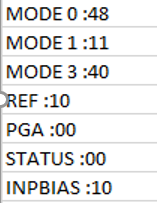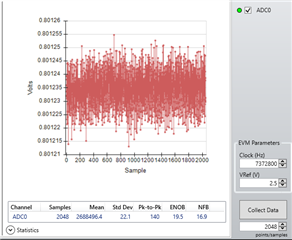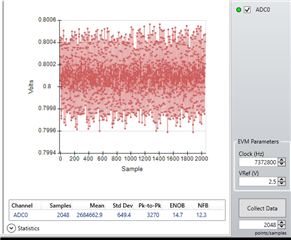Other Parts Discussed in Thread: ADS1261,
Hi Bryan,
I have a ADS1261 EVM connected to a NXP microcontroller. I did below two experiments.
1) Measured the Internal Signal (i.e., Internal (AVDD - AVSS) / 4 positive and Internal (AVDD - AVSS) / 4 negative) by configuring the INPMUX register. below is the ADC register configuration.

1200SPS,SINC1,Pulse conversion,50us delay, Internal Reference, PGA=1. Sometime you said, with this configuration we should get 17.5 noise-free bits. bit actually I am seeing 15 bit accuracy. I took the log and attached.
Please see Internal-signal sheet, where column 1 is the actual 24 bit value. column 2, I just took the MSB 16 bits from 24 bit counts. column3 is the decimal equivalent of column2 values. At the end, I calculated the variation between 16 bit counts and observed the difference as 1.
2) Measured the external signal (3.3V is given to positive input and 2.5V is given to negative input). Both these 3.3v and 2.5v are taken from evaluation board itself(via test points). register configuration is same as experiment 1, except the INPBIAS register is not configured. Here the noise free bits are 14.
Please see external-signal sheet, where column 1 is the actual 24 bit value. column 2, I just took the MSB 16 bits from 24 bit counts. column3 is the decimal equivalent of column2 values. At the end, I calculated the variation between 16 bit counts and observed the difference as 3.
My questions are
a) why I am not seeing the 17.5 noise free bits with above ADC configuration?
b) Is there any settings should be done on EVM? EVM is powered via USB and except the SPI connections from controller no other connections are made on EVM.
Please advise.
thanks,
Ram.



